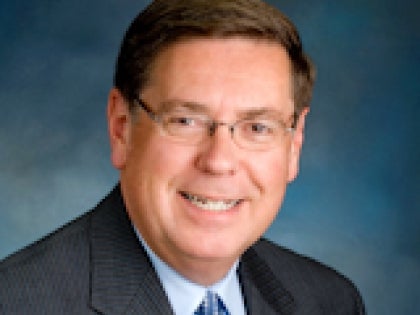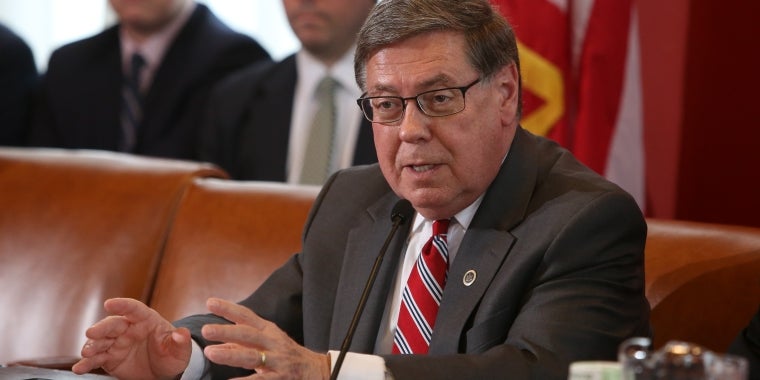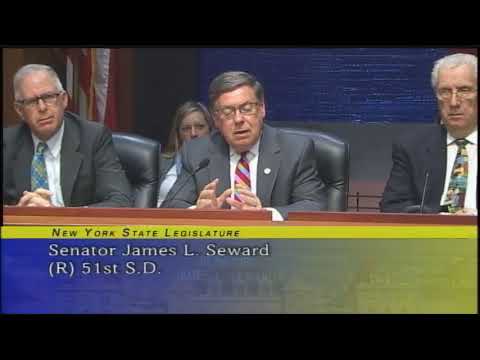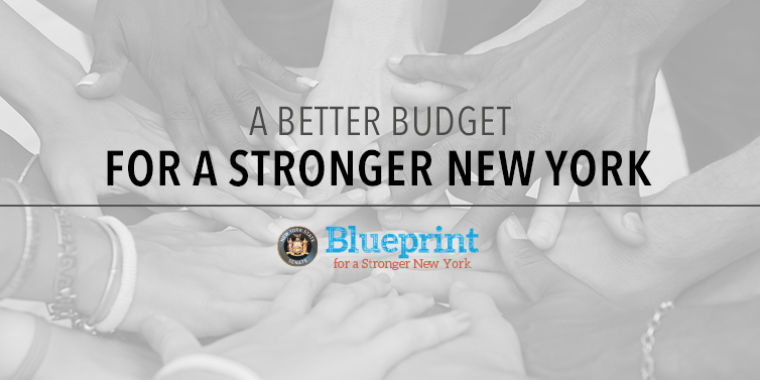
Senate Majority Proposes $2.4 Billion Property Tax Relief Plan
In an effort to reduce the enormous burden of some of the highest property taxes in the country, Senator James L. Seward andmembers of the senate majority conference today proposed the REBATE-NY plan, a comprehensive, 24 point plan to provide more than $2.4 billion in school and municipal property tax relief over the next three years, including direct rebate checks to property taxpayers, expanding the STAR program and the property tax circuit breaker, and encouraging consolidation and sharing of local government services.
The senate plan would save property taxpayers approximately $1.4 billion in the 2006-07 state fiscal year.
"Over the past 12 years, the senate majority has initiated tax relief plans that have significantly reduced business and personal income taxes to make New York more competitive with other states," Senator Seward said. "With the plan we are unveiling, the senate majority is sharpening its focus on reducing property taxes, which are among the highest in the nation. Our property tax burden is the largest tax billfor millions of New Yorkers. Providing substantial property tax relief through this plan will be the senate’s top priority in the next session."
"This is a very comprehensive plan that attacks the problem of high property taxes from several different angles and represents the input and recommendations of many members of the senate majority conference," Senate Majority Leader Joseph L.Bruno said. "Enacting this plan as part of the 2006-07 budget would be major victory for taxpayers throughout the state."
Highlights of the 24 point plan include:
> $1.9 billion in direct rebate checks to property taxpayers;
> Adjusting the STAR exemption to account for increased property assessments, saving property taxpayers an additional $250 million;
> Enhancing the property tax circuit breaker for homeowners to save an additional $100 million; > Limiting school budgets to one district vote, saving taxpayers approximately $150 million; and
> Expanded municipal shared services program.
"High property taxes have a crippling effect on every community, every taxpayer," said State Senator Owen H. Johnson (R-C, Babylon), chairman of the finance committee. "Local taxpayersacross the state are in need of significant property tax relief. This plan would give relief to struggling homeowners in the form of direct rebates and would also control costs at the local level that impact property taxes. When fully phased in, our plan would save local property taxpayers $2.3 billion in school and municipal taxes."
A soon-to-be released report by Global Insight found that local property taxes in New York State averaged $3,750 per household, exceeded only by the states of Connecticut and New Jersey. When combined with local sales, income and other taxes, the local tax burden in New York averaged $6,377 per household, the highest in the continental U.S. and more than twice the national average of $2,952.
Property taxes have increased by 19.6 percent over the 1997-2002 period in New York, reflecting an increase in local government expenditures by 30 percent. School tax levies alone have increased by an average annual rate of 7.7 percent since 2001. Over the previous three years, county officials have pointed fingers at Albany as the rootof ever increasing property taxes, blaming increased growth in Medicaid and pension payments as the need to increase property taxes at times by double digit rates of growth.
However a closer examination of local government expenditures outside of the City of New York indicate that on average, local government expenditures attributable to Medicaid averaged 2.6 percent or about $1.4 billion of the $54.6 billion total local government spending in 2002. Education spending, of which slightly less than one-half is funded by the state, accounts for 49.8 percent of all local spending, a total of $27.2 billion. Local government spending on all other services such as highways, water, public protection, sanitation, etc. add up to 47.6 percent of local government spending for a total of $26 billion. Therefore, while Medicaid costs may be growing faster than other local government costs, it represents a much smaller share of the overall local tax burden, far surpassed by all other local government spending and public education.
In addition, the Global Insight report found that in 2002, local government spending was up to $4 billion higher in New York than the average of ten states delivering similar services. These costs are due to New York’s multi-jurisdictional approach to delivering local government services as well as a higher cost of delivering these services, requiring $2.3 billion in additional local taxes and $1.7 billion in additional state support.
REBATE - NY
Tax Savings Proposals
Ÿ STAR Exemption Annual Adjustment;
Ÿ Voter Initiative Tax Rate Cap;
Ÿ One School Budget Vote;
Ÿ Local School Finance Reform Commission;
Ÿ Expanded School Report Card;
Ÿ Smaller Smarter Government Program;
Ÿ Expanded State Circuit Breaker for Homeowners;
Ÿ Reversible Mortgage Linked Deposit Program;
Ÿ STAR Exemption Annual Adjustment; and
Ÿ Income Tax Credit for Volunteer Firefighters in Lieu of Property Tax Exemptions
1Cost Savings
Ÿ Consolidation of School Districts; and
Ÿ School Superintendent Sharing
Accountability/Results
• Municipal Shared Services, Smaller Smarter Government Program;
Ÿ Require Board of Elections to Oversee Budget Votes;
Ÿ Shorten the Term of School Board Members to Two Years;
Ÿ Truth-In-Voting;
Ÿ Whistle Blower Protections;
Ÿ Expanded School Report Card;
Ÿ Special Education Audits;
Ÿ Performance Assistance Support Services Aid (PASS);
Ÿ Alternative Certification for Superintendents;
Ÿ Increase Aid to Municipalities for reevaluation from $5 per parcel to $15 per parcel;
Ÿ Biennial Justification of a Property Tax Exemption; and
Ÿ Clarify Statutory Definitions for Property Tax Exemptions
SENATE MAJORITY REBATE-NY
PROPERTY TAX RELIEF PLAN
Create a New Property Tax Rebate Program -- $1.9 Billion in Savings
To provide immediate taxpayer relief, the senate majority calls for a $1.9 billion property tax rebate program to be phased in over three years. Under the rebate program property taxpayers would receive an additional 75 percent of their current STAR property tax credit in the form of a direct rebate check. Under this initiative, a taxpayer would receive a rebate check for a portion of school taxes paid on a primary residential home. The value of this rebate would be based on taxes paid in the previous school year and would begin with rebate checks in September 2006 based upon school taxes paid for the 2005-06 school year. The value of the rebate would be calculated as a percentage of the homeowner’s benefit from the STAR program.
"The reports of homeowners, particularly senior citizens struggling to keep up with the rising property tax burden, are becoming all too familiar," said Senator Steve Saland, chair, senate education committee. "Under our tax rebate program every homeowner would realize property tax savings through receipt of a rebate check refunding a portion of their paid school property taxes. Building on the success of STAR, this program will provide a welcome relief to families across New York State."



